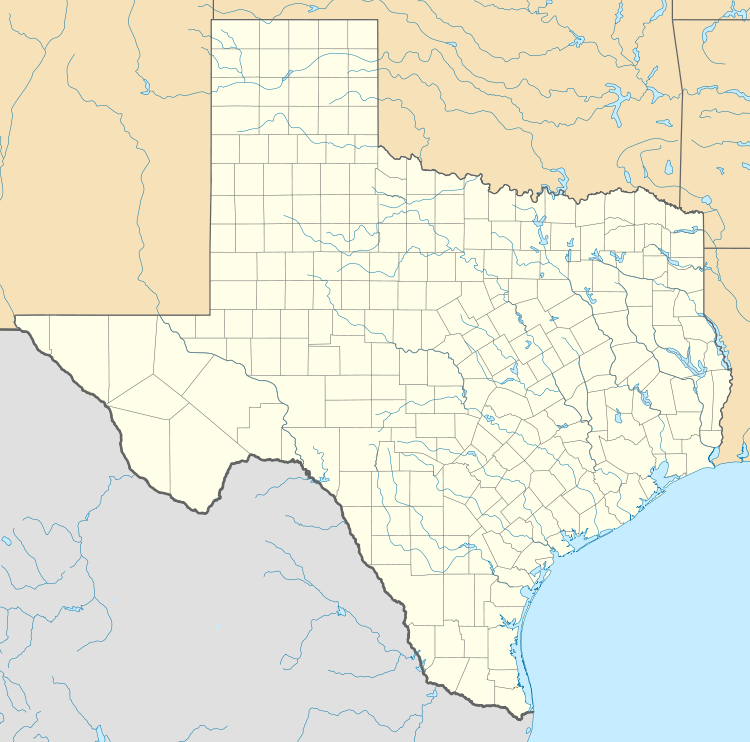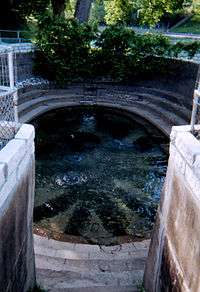Barton Springs
| Barton Springs | |
|---|---|
 Main Barton Spring, inside Barton Springs Pool | |
| Location | Austin, Texas, United States |
| Spring source | Edwards Aquifer |
| Elevation | 435 ft (133 m) above sea level |
| Type | Karst spring |
| Provides water for | Barton Creek and Colorado River |
| Magnitude | 2 |
| Discharge | 66 ft³/s (1869 L/s) |
|
Barton Springs Archeological and Historical District | |
  | |
| Location | Zilker Park, Austin, Texas |
|---|---|
| Coordinates | 30°18′27″N 97°43′49″W / 30.30750°N 97.73028°WCoordinates: 30°18′27″N 97°43′49″W / 30.30750°N 97.73028°W |
| Area | 138.5 acres (56.0 ha) |
| Built | 1891 |
| Architectural style | Tudor Revival, Bungalow/Craftsman, Queen Anne |
| MPS | HBarton Springs MPS |
| NRHP Reference # | 85003213[1] |
| Added to NRHP | November 27, 1985 |
Barton Springs is a set of four natural water springs located on the grounds of Zilker Park[2] in Austin, Texas, resulting from water flowing through the Edwards Aquifer. The largest spring, Main Barton Spring (also known as Parthenia, "the mother spring") supplies water to Barton Springs Pool, a popular recreational destination in Austin. The smaller springs are located nearby, two with man-made structures built to contain and direct their flow. The springs are the only known habitat of the Barton Springs Salamander, an endangered species.[3]
The Barton Creek National Archeological and Historic District was formed in 1985.
Geology
Barton Springs is the main discharge point for the Barton Springs segment of the Edwards Aquifer of Texas, a well known karst aquifer. Geologically, the aquifer is composed of limestone from the Cretaceous period, about 100 million years old. Fractures, fissures, conduits, and caves have developed in this limestone. Both physical forces, such as faulting, and chemical forces, such as dissolution of limestone by infiltrating water, have enlarged these voids. This results in a karst aquifer made up of limestone with large void spaces. Water then enters the aquifer and fills the voids.[4]
All water discharging from Barton Springs originates as rainfall. Some of this rain falls directly onto the area of land where the aquifer limestone rock is exposed, which is known as the recharge zone. Other rainfall enters into creeks that cross the recharge zone, and infiltrates the limestone bedrock. After water enters the aquifer, it flows along the gradients created by differences in hydraulic pressure into the area of lowest hydraulic pressure. This lowest point of hydraulic pressure is Barton Springs.
Main spring
Main Barton Spring/Parthenia is the most famous, yet least visible of the four springs as it is completely submerged by pool water. Located near the diving board in Barton Springs Pool, the spring's flow is not always visible at the surface. The spring is not always available for swimming purposes. Call in advance (512) 476-9044.
The main spring discharges an average flow of about 31 million US gallons (120,000 m3) per day. The lowest discharge ever recorded was 9 million US gallons (34,000 m3) per day during the drought of the 1950s, and the highest discharge ever recorded was 85 million US gallons (320,000 m3) per day during the December 1991 floods. By comparison, a typical domestic swimming pool holds about 50,000 US gallons (190 m3), and the City of Austin, a city of about 775,000 residents, uses about 220 million US gallons (830,000 m3) per day for its public water supply system.[5]
Other springs

The three other springs associated with Barton Springs are Eliza, Old Mill, and Upper Barton Spring. Each is significantly smaller than Main Barton Spring, discharging an average of 3 million US gallons (11,000 m3) per day. Sometimes, these springs dry up completely.
Eliza Spring, also known as Concession Spring, is located on the northwestern side of Barton Springs Pool behind the concession stand. During the early 20th century, an amphitheater-style swimming enclosure was built around the spring. This structure is no longer open to the public due to safety concerns, and the fact that Eliza Spring has become a sensitive habitat area for the endangered Barton Springs Salamander.
Old Mill Spring, also known as Sunken Gardens Spring or Zenobia Spring, is located on the northeastern side of Barton Springs Pool. Like Eliza Spring, the early 20th century structure built around the spring is now closed to public access due to safety and endangered species habitat issues. Scientific analysis show that the water at Old Mill Spring has a slightly different chemistry than that of Main Barton Spring and Eliza Spring, even though it is less than half a mile (800 m) away from these springs.
Upper Barton Spring is located in the creek bed of Barton Creek, about a half mile (800 m) upstream of Barton Springs Pool. Frequently dry, Upper Barton Spring is fully submerged by Barton Creek during floods. The water at Upper Barton Spring also has a significantly different chemistry than the other springs.
The entire area around Barton Springs is riddled with faults from the Balcones Fault Zone and features other, smaller springs. For example, about one mile (2 km) upstream of Upper Barton Spring, an intermittent spring fills a popular natural swimming hole. Several other small springs empty directly into the Barton Creek bypass tunnel that passes to the side of Barton Springs Pool.[6]
Fauna
Two salamander species are endemic to Barton Springs (are known from nowhere else): Barton Springs salamander and Austin blind salamander.[7]
Notes
- ↑ National Park Service (2009-03-13). "National Register Information System". National Register of Historic Places. National Park Service.
- ↑ Gregg Eckhardt. 2009
- ↑ Gunnar, Brune. "Barton Springs". Retrieved Sep 12, 2011.
- ↑ Eckhardt, Gregg (2009). "Edwards Aquifer and Barton Springs". Edwards Aquifer. Retrieved Sep 12, 2011.
- ↑ "USGS 08155500 Barton Spgs at Austin, TX". United States Geological Society. July 15. Check date values in:
|date=(help); - ↑ Lai, Valeria (July 23, 2010). "Barton Springs". Retrieved Sep 11, 2011.
- ↑ Frost, Darrel R. (2014). "Amphibian Species of the World: an Online Reference. Version 6.0". American Museum of Natural History. Retrieved 14 February 2015.
